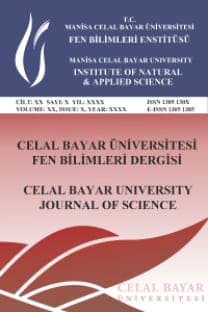Investigation of Electronic Structure - Bioactive Nature Relation in Niacin Derivates by DFT Calculations and Molecular Docking
Investigation of Electronic Structure - Bioactive Nature Relation in Niacin Derivates by DFT Calculations and Molecular Docking
___
- [1] Karabacak, M., S. Bilgili, and A. Atac. Molecular structure investigation of neutral, dimer and anion forms of 3,4-pyridinedicarboxylic acid: A combined experimental and theoretical study. Spectrochimica Acta Part A: Molecular and Biomolecular Spectroscopy, 2015; 135(0): 270-282.
- [2] Nataraj, A., V. Balachandran, T. Karthick, M. Karabacak, and A. Atac. FT-Raman, FT-IR, UV spectra and DFT and ab initio calculations on monomeric and dimeric structures of 3,5-pyridinedicarboxylic acid. Journal of Molecular Structure, 2012; 1027(0): 1-14.
- [3] Koczoń, P., J.C. Dobrowolski, W. Lewandowski, and A.P. Mazurek. Experimental and theoretical IR and Raman spectra of picolinic, nicotinic and isonicotinic acids. Journal of Molecular Structure, 2003; 655(1): 89-95.
- [4] Hamoud, S., T. Hayek, A. Hassan, E. Meilin, M. Kaplan, R. Torgovicky, and R. Cohen. Niacin Administration Significantly Reduces Oxidative Stress in Patients With Hypercholesterolemia and Low Levels of High-Density Lipoprotein Cholesterol. The American Journal of the Medical Sciences, 2013; 345(3): 195-199.
- [5] Kamanna, V.S. and M.L. Kashyap. Mechanism of Action of Niacin. The American Journal of Cardiology, 2008; 101(8, Supplement): S20-S26.
- [6] Investigators, A.-H. The role of niacin in raising highdensity lipoprotein cholesterol to reduce cardiovascular events in patients with atherosclerotic cardiovascular disease and optimally treated low-density lipoprotein cholesterol Rationale and study design. The Atherothrombosis Intervention in Metabolic syndrome with low HDL/high triglycerides: Impact on Global Health outcomes (AIM-HIGH). Am Heart J, 2011; 161(3): 471-477 e2.
- [7] Cinar, M., M. Karabacak, and A.M. Asiri. An experimental and density functional study on conformational and spectroscopic analysis of 5- methoxyindole-2-carboxylic acid. Spectrochimica Acta Part A: Molecular and Biomolecular Spectroscopy, 2015; 137(0): 670-676.
- [8] Karabacak, M., M. Cinar, M. Kurt, P. Chinna babu, and N. Sundaraganesan. Experimental and theoretical FTIR and FT-Raman spectroscopic analysis of 1- pyrenecarboxylic acid. Spectrochimica Acta Part A: Molecular and Biomolecular Spectroscopy, 2013; 114(0): 509-519.
- [9] Suksrichavalit, T., S. Prachayasittikul, T. Piacham, C. Isarankura-Na-Ayudhya, C. Nantasenamat, and V. Prachayasittikul. Copper Complexes of NicotinicAromatic Carboxylic Acids as Superoxide Dismutase Mimetics. Molecules, 2008; 13(12): 3040.
- [10] Borhani, D.W., D.P. Rogers, J.A. Engler, and C.G. Brouillette. Crystal structure of truncated human apolipoprotein A-I suggests a lipid-bound conformation. Proceedings of the National Academy of Sciences of the United States of America, 1997; 94(23): 12291-12296.
- [11] Frisch, M.J., G.W. Trucks, H.B. Schlegel, G.E. Scuseria, M.A. Robb, J.R. Cheeseman, G. Scalmani, V. Barone, B. Mennucci, G.A. Petersson, H. Nakatsuji, M. Caricato, X. Li, H.P. Hratchian, A.F. Izmaylov, J. Bloino, G. Zheng, J.L. Sonnenberg, M. Hada, M. Ehara, K. Toyota, R. Fukuda, J. Hasegawa, M. Ishida, T. Nakajima, Y. Honda, O. Kitao, H. Nakai, T. Vreven, J.A. Montgomery Jr., J.E. Peralta, F. Ogliaro, M.J. Bearpark, J. Heyd, E.N. Brothers, K.N. Kudin, V.N. Staroverov, R. Kobayashi, J. Normand, K. Raghavachari, A.P. Rendell, J.C. Burant, S.S. Iyengar, J. Tomasi, M. Cossi, N. Rega, N.J. Millam, M. Klene, J.E. Knox, J.B. Cross, V. Bakken, C. Adamo, J. Jaramillo, R. Gomperts, R.E. Stratmann, O. Yazyev, A.J. Austin, R. Cammi, C. Pomelli, J.W. Ochterski, R.L. Martin, K. Morokuma, V.G. Zakrzewski, G.A. Voth, P. Salvador, J.J. Dannenberg, S. Dapprich, A.D. Daniels, Ö. Farkas, J.B. Foresman, J.V. Ortiz, J. Cioslowski, and D.J. Fox, Gaussian 09. 2009, Gaussian, Inc.: Wallingford, CT, USA.
- [12] Roy Dennington, T.K., and John Millam, GaussView, in Semichem Inc. 2009.
- [13] Parr, R.G. and W. Yang. Density functional approach to the frontier-electron theory of chemical reactivity. Journal of the American Chemical Society, 1984; 106(14): 4049-4050.
- [14] Young, D.C., Density Functional Theory, in Computational Chemistry. 2001, John Wiley & Sons, Inc. p. 42-48.
- [15] Atac, A., M. Karabacak, C. Karaca, and E. Kose. NMR, UV, FT-IR, FT-Raman spectra and molecular structure (monomeric and dimeric structures) investigation of nicotinic acid N-oxide: A combined experimental and theoretical study. Spectrochimica Acta Part A: Molecular and Biomolecular Spectroscopy, 2012; 85(1): 145-154.
- [16] Yildiz, N., M. Karabacak, M. Kurt, and S. Akkoyun. Neural network consistent empirical physical formula construction for density functional theory based nonlinear vibrational absorbance and intensity of 6-choloronicotinic acid molecule. Spectrochimica Acta Part A: Molecular and Biomolecular Spectroscopy, 2012; 90(0): 55-62.
- [17] Karabacak, M. and M. Kurt. Comparison of experimental and density functional study on the molecular structure, infrared and Raman spectra and vibrational assignments of 6-chloronicotinic acid. Spectrochimica Acta Part A: Molecular and Biomolecular Spectroscopy, 2008; 71(3): 876-883.
- [18] Lu, T. and F. Chen. Multiwfn: A multifunctional wavefunction analyzer. Journal of Computational Chemistry, 2012; 33(5): 580-592.
- [19] Morris, G.M., D.S. Goodsell, R.S. Halliday, R. Huey, W.E. Hart, R.K. Belew, and A.J. Olson. Automated docking using a Lamarckian genetic algorithm and an empirical binding free energy function. Journal of Computational Chemistry, 1998; 19(14): 1639-1662.
- [20] Trott, O. and A.J. Olson. AutoDock Vina: Improving the speed and accuracy of docking with a new scoring function, efficient optimization, and multithreading. Journal of Computational Chemistry, 2010; 31(2): 455-461.
- [21] Yang, J.-M. and T.-W. Shen. A pharmacophore-based evolutionary approach for screening selective estrogen receptor modulators. Proteins: Structure, Function, and Bioinformatics, 2005; 59(2): 205-220.
- [22] Yang, J.-M. and C.-C. Chen. GEMDOCK: A generic evolutionary method for molecular docking. Proteins: Structure, Function, and Bioinformatics, 2004; 55(2): 288- 304.
- [23] Sjoberg, P., J.S. Murray, T. Brinck, and P. Politzer. Average local ionization energies on the molecular surfaces of aromatic systems as guides to chemical reactivity. Canadian Journal of Chemistry, 1990; 68(8): 1440-1443.
- ISSN: 1305-130X
- Yayın Aralığı: 4
- Başlangıç: 2005
- Yayıncı: Manisa Celal Bayar Üniversitesi Fen Bilimleri Enstitüsü
Lütfullah GÜNDÜZ, Şevket Onur KALKAN, Ferruh ERTAN
Subdivision of the Spectra for the Generalized Difference Operator , on the Sequence Space ( < < ∞)
Murat DEMİR, Ali Bekir YILDIZ, Mustafa KAVCI, Mustafa NİL
Sezai Taşkın, Yiğit Karabulut, Ali BAKBAK, Ömer Faruk Kale, Erdem Geren
Aybike ÖZYÜKSEL ÇİFTÇİOĞLU, Erkan DOĞAN
Finding the Lie Symmetries of Some First-Order Odes via Induced Characteristic
